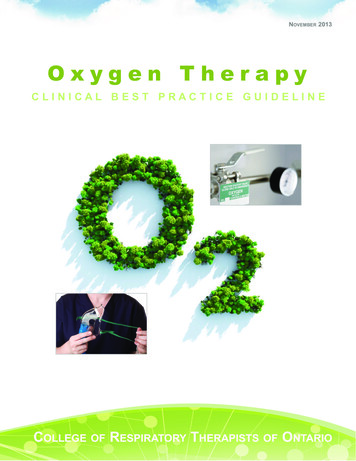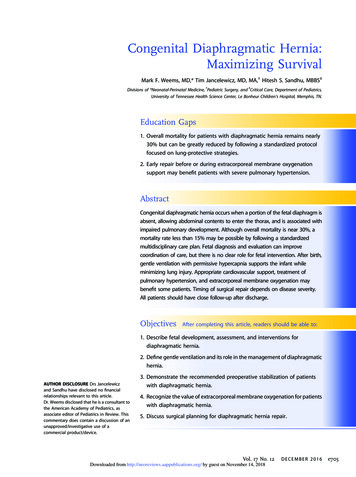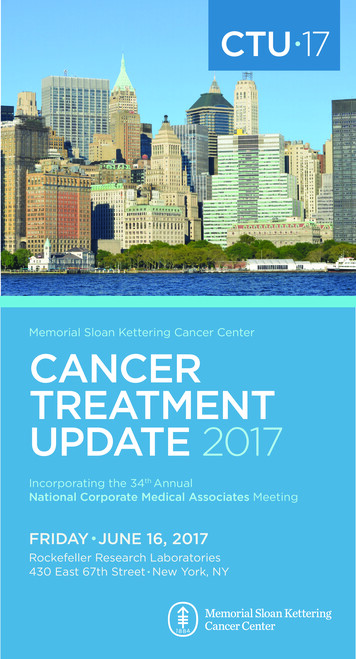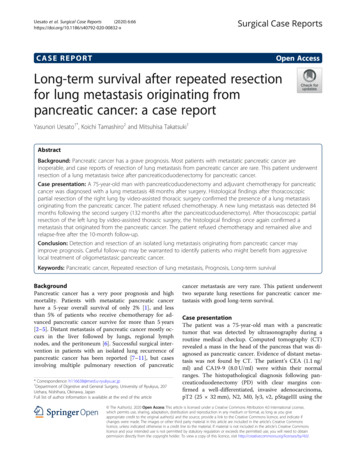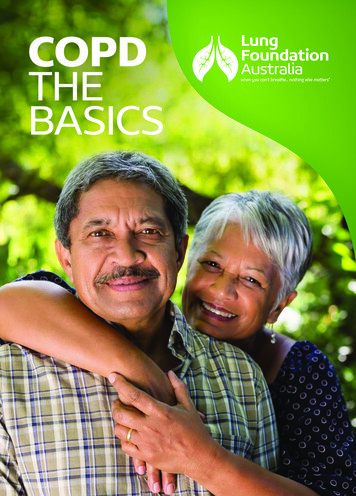
Transcription
COPDTHEBASICS
Title: COPD The BasicsFor people living with Chronic Obstructive Pulmonary Disease(COPD), their families, carers and friends.First published: April, 2015 This edition: August, 2018 Lung Foundation Australia ISBN: 978-0-9872272-7-0Editor/s: Lung Foundation AustraliaDesigner: Wayne Froneman, Oyo Studio Printer: AllClearThis booklet was developed with the input of Lung FoundationAustralia COPD committee members, including respiratoryphysicians, health professionals, and patients living with COPD.Note to reader:This information is intended as a general guide only and is not intended or implied to be asubstitute for professional medical advice or treatment. While all care is taken to ensureaccuracy at the time of publication, Lung Foundation Australia and its members excludeall liability for any injury, loss or damage incurred by use of or reliance on the informationprovided. Always consult with your doctor about matters that affect your health.Lung Foundation AustraliaLevel 2/11 Finchley St Milton,Brisbane, QLD 4064T: 07 3251 3600 F: 07 3368 3564E: com.auABN: 360511319012
IntroductionThis booklet contains information for people who haverecently been diagnosed with Chronic Obstructive PulmonaryDisease (COPD). It is also a useful guide for family members orfriends who provide support to a loved one living with COPD.It has been designed to help you understand more about thecondition of COPD and the treatment options available.By being informed about your condition and taking steps toimprove your health, you can reduce the impact COPD has onyour life both now and in the future.If you have any questions about your health or about COPD, itis important that you talk to your doctor or another memberof your healthcare team.See the back cover of this booklet for information on LungFoundation Australia services and useful websites andorganisations.Lung Foundation Australia’s passionate andexperienced Information and Support Teamprovides trusted advice, information and support topatients, carers and health professionals. Contactus via freecall 1800 654 301 to find out more.COPD The Basics3
4
Table ofContentsAbout COPD6Understanding COPD7Causes8Symptoms8Diagnosis10Treatment11Coping with a flare-up17Understanding COPD medicines19Oxygen therapy23Get to know your healthcare team24Useful websites26About Lung Foundation Australia27COPD The Basics5
About COPDWhat is COPD?Chronic Obstructive Pulmonary Disease (COPD) is a progressive lung condition thatcauses narrowing of the bronchial tubes in the lungs (sometimes called bronchi orairways), making it difficult to breathe. Sometimes air gets trapped in the lungscausing the feeling of breathlessness. When the condition occurs it is chronic(long-term) in nature, however it is important to remember that you are not aloneand there are things you can do to help manage the symptoms and improve youroverall quality of life.COPD is an umbrella term for a group of lung conditions including: Emphysema Chronic bronchitis Chronic asthmaCOPD in AustraliaCOPD is a common lung condition affecting both men and women. Around 1 in 7Australians aged 40 years and over have some form of COPD2 however around halfof the people living with COPD symptoms do not know they have the condition3.Indigenous Australians are 2.5 times more likely to have COPD than nonIndigenous Australians4. Whilst COPD is not a contagious disease, it is the secondleading cause of avoidable hospital admissions in Australia4.Asthma-COPD OverlapAround 20% of people with COPD also have asthma which is describedas asthma-COPD overlap (also called asthma-COPD overlap syndrome,or ACOS)1. Asthma-COPD overlap is not a disease on its own and mayhave several different causes. People with asthma-COPD overlap needdifferent treatment from people with just asthma or COPD alone.6
Understanding COPDWhat is emphysema?Emphysema is a condition in which air gets trappedinside the lungs making it harder to breathe inagain. The main symptom of emphysema isbreathlessness.*Figure 1What is chronic bronchitis?Chronic bronchitis is a constant and long-lastingirritation and swelling of the airways. The mainsymptoms of chronic bronchitis are cough andincreased secretions from the lungs such as mucus.**Figure 2What is chronic asthma?Asthma is a condition that affects the smallairways. When you experience asthmasymptoms the muscles in the airwaystighten and the lining of the airways swell***Figure 3and produce sticky mucus. These changescause the airways to become narrow, meaning there is less space for theair to flow in and out of your lungs.Usually with asthma, medicines can reverse symptoms and open theairways. In chronic asthma, however, the medicines do not fully openthe airways, meaning it is irreversible. This is categorised as COPD.*Figure 1: Air trapped inside the air sacs (alveoli)**Figure 2: Swelling and increased mucus production in the airways***Figure 3: Tightening of muscles and swelling of airwaysCOPD The Basics7
CausesThere are many causes of COPD, which may include: Smoking: this includes if you currently smoke, have smoked in the past, or areexposed to passive smoking. Environmental factors: such as working or living in areas where there is dust,gas, chemical fumes, smoke or air pollution. Genetic: A small number of people have a form of emphysema caused by a proteindisorder called alpha-1 antitrypsin deficiency (AATD). This is where the body finds itdifficult to produce one of the proteins (Alpha-1) which protects the lungs.SymptomsThe first symptoms of COPD can be subtle and may overlap with other lung andheart conditions. They may also be mistaken for signs of getting older, beingoverweight or unfit. COPD is a progressive lung condition with three stages:1. Mild COPDThe first symptoms of COPD tend to come on slowly and can be very mild. In the earlystages, you may not have symptoms all the time and you may find there is very littleor no impact on your life or independence. You may cough up mucus in the morningsor feel more short of breath than usual if you walk quickly or exert yourself.2. Moderate COPDAs COPD progresses, you may notice symptoms almost every day and find itharder to do your normal daily activities such as gardening, hanging out thewashing, or carrying groceries without feeling short of breath. Other symptomsmay include: A repetitive cough that doesn’t get better(this is due to a buildup of mucus in the airways) Increased mucus production, whichis often thick, and white or brownish in colour Feeling tired More chest infections or taking a bit longer torecover from a cold or chest infection.8
“I thought I was just getting older and sufferingfrom the effects of years of smoking. I didn’trealise there was a name for what I have and thatthere was something I could do to feel better.”Donna, lives with COPD3. Severe COPDIn severe COPD, you will likely experience symptoms most ofthe time. You may: Find it hard to walk up stairs or across the room withoutfeeling very short of breath Feel tired more of the time, despite resting Cough frequently and cough up a lot more mucus Feel frustrated with the constant need to clear your mucusfrom your airways Get chest infections frequently Take several weeks to recover from a cold or chest infection.COPD The Basics9
DiagnosisWhile there is currently no cure for COPD,research shows that early diagnosis,combined with disease managementprograms at the early stage of thecondition, can improve quality of life,slow progression, reduce mortality andkeep people out of hospital.5Diagnostic tests for COPD can include:Lung function tests (breathing tests)Spirometry is the most commonbreathing test used to confirm adiagnosis of COPD. The tests involvesblowing as long and hard as you caninto a tube connected to a (spirometry)machine. The machine assesses howwell your lungs work by measuring howmuch air you can inhale, how much youcan exhale and how quickly you canexhale. The results will let your doctorknow if you have COPD or another lungcondition such as asthma.FEV1 is the amount of air you canforcefully blow out of your lungs in onesecond. It is an important breathingtest measure for airflow obstruction,such as from COPD.Your doctor will compare your FEV1with standards (called predictedvalues) for a person without lungconditions, who is of comparable age,gender and height. From this10Figure 4: Spirometry is used toconfirm a diagnosis of COPDcomparison your doctor will calculate apercentage. This is used to stage COPDas mild, moderate or severe.Other tests may include:Chest X-ray: takes pictures of thetissues in the lungs and surroundingorgans.CT Chest: takes more detailed picturesthan an X-ray to look at the lungs andsurrounding organs.Arterial blood gas analysis: a bloodtest that measures how well your lungsbring oxygen into your blood andremove carbon dioxide.Laboratory tests: these are not usedto diagnose COPD, but may be used torule out other conditions or to work outthe cause of your symptoms.
TreatmentCan COPD be cured?Although the damage to your lungs cannot be reversed, early treatment isimportant to help improve how you feel. By taking the following steps you canimprove your overall quality of life, slow the progression of symptoms, and keepyour COPD well managed, including reducing the risk of flare-ups.Quit smokingNot all people with COPD have smoked, however, if you do smoke, quitting is thesingle most important thing you can do to improve your health and lung function.If you continue to smoke, your health and respiratory symptoms will worsen. Thesooner you quit, the better your chances of living well and improving your lungfunction.Do not feel guilty about having smoked. Most people say they would like to quit,and may have tried at least once. Some are successful the first time but others trymany times before they finally give up for good. A quit plan can help you reflecton why you smoke and your motivations for quitting, and help you choose yourpreferred quit tools. These can include: Nicotine replacement therapy (NRT) products. Support options such coaching and/or counselling. Other strategies to help you plan for success, such as making changes to yourdaily routine to reduce the temptation to smoke.COPD The Basics11
“I was suffering from shortness of breathand when I started trying to get fit, I couldn’t getaround the block. Any minor incline was a challengeand set me off coughing. Since quitting, I’m running 30to 40km a week and I don’t cough as much.”Roy, lives with COPDStay healthy and activeStudies have shown that people with chronic lung conditions use 25 – 50% moreenergy than people with normal lung function5. This is mostly due to the changesin your lungs, increased work of breathing and using more energy to fight chestinfections or flare-ups, which are more common in people with COPD. There arelots of things you can do to make sure you stay healthy and have energy to dothe things you enjoy, including: Eat a healthy, nutritious diet Be physically active Get enough rest and good quality sleep Look after your wellbeing by enjoying friends, family and hobbies. Practisingrelaxation techniques can also help reduce feelings of stress or anxiety.12
Your weight can have an impact on your energy levels, mobility and symptomssuch as breathlessness. If you are underweight, your body has less nutrientstores. You may get tired more easily and your muscles, including your breathingmuscles, can become weak. Being underweight can also increase your risk ofgetting infections.If you are overweight, this can increase your breathlessness, making it hard for youto do daily activities like walking up stairs or carrying groceries. It also increasesyour risk of developing other health conditions such as high blood pressure, highcholesterol and type 2 diabetes.The Australian Dietary Guidelines say that you should enjoy a wide variety ofnutritious foods from these five groups every day: Vegetables: including different typesand colours, and legumes/beans. Fruit grain (cereal) foods: mostlywholegrain and/or high cereal fibervarieties, such as breads, cereals, rice,pasta, noodles, polenta, couscous,oats, quinoa and barley. Lean meats and poultry: fish,eggs, tofu, nuts and seeds, andlegumes/beans. Dairy: including milk, yoghurt, cheese and/or their alternatives, mostly reduced fat.You should also drink plenty of water and limit intake of foods containingsaturated fat, added salt, added sugars and alcohol.It is important to get advice that is specific to you and your condition. AnAccredited Practising Dietician (APD) can help you understand what your healthyweight range is. They can also help you set goals and develop healthy eating plansto ensure you are getting the right nutrition.COPD The Basics13
ExerciseIf you get breathless during your normal daily activities you may start to avoidexercise, however, this can cause your muscles to get weak and you will losefitness over time. COPD research has shown that regular exercise can helpmaintain your fitness, improve your wellbeing and reduce symptoms, such asbreathlessness.You should aim to exercise for at least 30 minutes, five times a week. It’simportant to note that you do not have to do all 30 minutes at once. For somepeople this will be achievable whilst others will need to break the 30 minutes intosmaller sessions. The activity you do should make you a little out of breath. It’simportant to talk with a health professional, such as a physiotherapist, aboutwhat type of exercise would suit you.Pulmonary RehabilitationPulmonary rehabilitation is an exercise and education program providedby specially trained health professionals. It teaches you the skills youneed to exercise safely and manage your breathlessness. Researchshows that pulmonary rehabilitation is one of the best things you can doto improve your breathing and wellbeing. It also reduces the frequencyof COPD flare-ups and helps you stay well and out of hospital.Lungs in ActionAfter you finish pulmonary rehabilitation, it is important to continueexercising to help maintain your physical fitness and lung health. LungFoundation Australia’s Lungs in Action program is a safe and funcommunity-based exercise class designed to help people with a chroniclung disease maintain the benefits achieved through pulmonaryrehabilitation.14
“Pulmonary rehabilitation made such adifference for me that my doctor took me offthe waiting list for lung reduction surgery, and Iam now back at work two days a week.”John, lives with COPDCOPD The Basics15
Ensure your vaccinations are up-to-dateSupport your immune system and reduce the risk of flare-ups by having yourvaccinations. Influenza: A yearly influenza vaccine has been shown to reduce risk of deathand hospital admissions. Pneumonia: It’s important to remember that no matter how healthy and activeyou are, your risk of getting pneumococcal pneumonia increases with age. This isbecause the immune system naturally weakens as we get older, making itharder for our bodies to fight off infections and diseases. Talk with your doctorabout the best way to protect yourself against pneumococcal pneumonia.Access emotional supportEveryone experiences COPD differently. Initially your COPDmay not have much impact on your life or emotions,however as it progresses, it is important to access support.You may also experience changes in your mood or feelanxious. It can be difficult to know if you feel downbecause of your physical health or if you have symptomsof depression and/or anxiety. Your doctor or anothermember of your health care team can help you workthrough these feelings.There are also a number of community organisations thatspecialise in providing confidential help and support. Seethe back of this booklet for more information orcontact Lung Foundation Australia.16
Coping with a flare-upA COPD flare-up (or exacerbation) is when your symptoms worsen quickly,usually over a few days. It may be caused by an infection (often due to a virus) ortriggered by air pollutants or irritants. Flare-ups are more common during thewinter months and can make everyday activities difficult. It is important that youcan identify the early signs of a flare-up so you can start treatment as soon aspossible.Common symptoms of a flare-up include: Coughing more than usual Finding it harder to breathe (increased breathlessness) Changes in sputum (more, or thicker sputum) Being more tired than usual (less active).If you are experiencing any of the below symptoms you may need to go tohospital as your flare up may be severe.Phone an ambulance on 000 if you have any of the following: You find it hard to talk You find it hard to walk You can’t sleep because of shortness of breath You feel drowsy or confused Your lips or fingernails have turned grey or blue Your heartbeat or pulse is very fast or irregular.COPD flare-ups are serious!If you notice symptoms of a flare-up see your doctor as soon aspossible. Getting treatment early will reduce the severity of yourflare-up and may prevent the need to go to hospital.COPD The Basics17
Flare-ups can cause permanent damage to your lungs and make your COPDworse. Reduce your risk of a flare-up by: Taking your COPD medicines as instructed by your doctor. Supporting your immune system with influenza and pneumococcal pneumoniavaccinations. Staying away from people (including babies) who have colds, flu, sinusinfections and/or sore throats. Avoiding things that can make your symptoms worse such as fumes, dust orcold or very humid air.Our COPD Action Plan helpsyou recognise when yoursymptoms change. It alsoprovides you with actions totake to reduce the severity andlength of symptoms. Talk toyour doctor about making aCOPD Action Plan at your nextappointment.“I believe in doing what I can and being honestwith myself about my condition. Planning is a bigpart of my everyday living. I do this to make sure Iconserve energy and can make each day count”Ian, lives with COPD18
UnderstandingCOPD medicinesThere are a number of medicines that people with COPD can take to improve theirbreathing. Some work by helping to open up the airways, while others relax themuscles around the airways to make breathing easier. COPD medicines are mostcommonly taken using an inhaler device (sometimes called a puffer) to deliver themedicine directly into the lungs.There are three main categories of COPD medicines:1. Reliever medicinesReliever medicines should be used when you feel short of breath suddenly. Thesemedicines are called short-acting bronchodilators (pronounced bronk-oh-dye-lay-tors)and work by relaxing the muscles around the airways. This helps open theairways to allow air in and out of the lungs easily. This can reduce the feeling ofshortness of breath.Reliever medicines are effective within minutes of inhalation and last for severalhours.If you are using your reliever inhaler more often than prescribed, talk to your doctor.This may mean that your COPD medicines and management plan need to be reviewed.RelieversSABAVentolin MDISAMAAsmol MDI#Airomir MDIAiromir Autohaler Bricanyl Turbuhaler Atrovent MDIAlways make sure you carry your reliever inhaler with you whenyou leave the house in case you suddenly feel short of breath.COPD The Basics19
2. Maintenance medicinesMaintenance medicines are long-acting bronchodilators. Like reliever medicines,they work to open the airways by relaxing the muscles around them. Maintenancemedicines usually take longer than relievers to start working, however theireffects last longer – 12 to 24 hours depending on the medicine.There are two types of bronchodilators:1. Long-acting muscarinic antagonists (LAMA)2. Long-acting beta2-agonists (LABA)You can be prescribed one type of long-acting bronchodilator alone, or mayreceive a combination of two types, such as Ultibro (glycopyrronium bromide/indacaterol), Anoro (umeclidinium/vilanterol) Spiolto (tiotropium andolodaterol) and Brimica (aclidinium and eformoterol).COPD medicines containing corticosteroidsSome inhalers contain corticosteroids in addition to bronchodilators.Corticosteroids work by reducing inflammation, and help to make your airwaysless sensitive to irritants that can cause swelling and mucus production. Thesemedicines include Symbicort (budesonide and eformoterol), DuoResp (budesonide and eformoterol), Seretide (fluticasone and salmeterol), CiplaInhaler (fluticasone and salmeterol), Breo (fluticasone furoate/vilanterol)andTrelegy (fluticasone/umedclidium/eformoterol).This kind of combined medicine is usually prescribed for people with moderate tosevere COPD who have had two or more flare-ups over the previous year.Inhaled corticosteroids on their own are not used for people with COPD. They areused to treat asthma, and for those people that have both asthma and COPD.After using inhaled corticosteroids, is important to rinse the mouth to avoidpossible side effects.You only have to use one inhaler to take two medicines.Combined medicines can also reduce the risk of flare-ups.20
MaintenanceLAMALAMA/LABALABASpiriva HandiHaler Spiriva Respimat Ultibro Breezhaler Spiolto Respimat Onbrez Breezhaler *Foradile Aerolizer Incruse Ellipta Seebri Breezhaler Anoro Ellipta Brimica Genuair *Oxis Turbuhaler *Serevent Accuhaler ICS/LABABretaris Genuair Breo Ellipta Symbicort Rapihaler Seretide Accuhaler ICS (For patients with COPD and Asthma)Symbicort Turbuhaler Seretide MDI*Flixotide MDI*Pulmicort Turbuhaler *Flixotide Accuhaler *Alvesco MDIICS/LABA*QVAR MDI*Flutiform MDIICS/LAMA/LABADuoResp Salplus F/ Cipla Trelegy To get the most benefit out of these medicines, you shouldtake them each day, as instructed by your doctor. Used daily,they will help to reduce your COPD symptoms in the long term.COPD The Basics21
3. Flare-up medicinesThese medicines are forshort-term use when you areexperiencing a flare up. If takenearly, they can reduce the severityand duration of a flare-up. Your doctorwill tell you what medicines to take whenyour symptoms worsen and will write instructionsin your COPD Action Plan.AntibioticsAntibiotics will not help manage COPD on a day-to-day basis. They areprescribed if you have a flare-up due to infection. If the colour, amount and/ortexture of your mucus (phlegm) changes, this can mean you have an infection. Ifyou are prescribed antibiotic tablets by your doctor, make sure you take thetablets for as long as instructed, even if you start to feel better.Oral steroidsSteroid tablets can be prescribed for a short period of time to help treatsymptoms of a flare-up such as wheeze or breathlessness. Your doctor willnormally prescribe a course for 5 – 10 days. It is also important that you takethem at the time of day as instructed by your doctor. Do not stop taking steroidtablets suddenly without consulting a doctor.Take your medicine as instructedThe medicines prescribed by your doctor are tailored to you and your symptoms.It is important to take your medicines as instructed even when you feel well. Donot be tempted to decide when and how much medicine you will take. This willreduce the effectiveness of your medicine and could make your COPD worse.“Now that I am on the right medicine I am coping more withhousehold jobs, and enjoying life with my family and friends.There are still limitations, but I don’t feel as restricted.”Gaye, lives with COPD22
Learn how your medicines work. This will help you to understandwhy and when you need to take them. Ask your doctor, nurse orpharmacist: What your medicine is for How the medicine works How to take the medicine When the best time to take it is How long the dose is effective What the possible side-effects of the medicine are and how you canavoid or reduce them Whether the medicine will cause problems with any other medicineyou are taking To include all your medicines in your COPD Action Plan.Up to 90% of people with COPD do not know how to use theirinhaler device correctly. It is important for a trained healthprofessional (such as your doctor, nurse or pharmacist) to showyou how to use your inhaler and assist you to get the techniqueright. Correct use of your inhaler device is important and willensure you get the most benefit from your medicine.Oxygen therapyIn severe stage COPD your oxygen levels can be low and home oxygen may beprescribed by your doctor or specialist. While oxygen therapy can help to reducethe damage to your vital organs, it is not prescribed to stop breathlessness. Somepatients may need continuous oxygen while others may only require oxygenduring physical activity like walking or exercising. While oxygen therapy mayrelieve breathlessness in some people, in many cases it does not.COPD The Basics23
Get to know yourhealthcare teamAs well as your doctor, there other health professionals who can help you manageyour COPD - this is your healthcare team. A respiratory nurse, pharmacist,physiotherapist or dietician may be part of your healthcare team.You may choose to ask one or more of your family or friends to also be part ofyour healthcare team. They can assist by attending appointments with you orhelping you monitor your symptoms.Regular visits with your healthcare team are importantHaving regular contact with your healthcare team will help you to stay in controlof your COPD symptoms. You should go to your appointments even if you arefeeling well.You can talk to your healthcare team about: Changes in your symptoms, or flare-ups Your medicines, including any side effects Other conditions you may have and their impact on yourhealth and wellbeing Strategies to self-manage your COPD Environmental risk factors you may have recently beenexposed to such as smoking, dust or fumes.24
Tips for appointments with your healthcare teamTipsIt is important that you understand theinformation your healthcare team givesyou during appointments. It is alsoequally important that they understandyour personal needs and what isimportant to you. Show your list to your healthcareprofessional at the beginning of yourappointment and decide togetherwhat you will discuss during this visit.The following tips can help you getthe most out of your appointmentswith your doctor and other membersof your healthcare team: Ask your health professional to writeinformation in your notebook for youto refer to again. Keep a symptom diary to help youmonitor your symptoms over time.Discuss any change in symptoms atyour next appointment. Use a notebook to keep track of theinformation you discuss with yourhealthcare team. Take it with you toall appointments. Before your appointment make a list ofquestions and concerns in yournotebook. List them in order of priority.If you have a number of questions youmay need to make a longerappointment or schedule a second visit.COPD The Basics Take a friend or family member toyour appointments for support. If you don’t understand something,ask your healthcare professional torepeat the information or to explain itin a different way. Do not avoidasking questions because you areafraid or embarrassed. Yourhealthcare team is there to help you. Ask about the best way to contactyour healthcare team in case youhave medical questions, or if yoususpect a flare-up. Let your healthcare team know if youare worried about the cost of yourhealth treatments. They can help youfind the best solution.25
Useful WebsitesCOPD Online Patient Educationcope.lungfoundation.com.auC.O.P.E. is a free and easy to use and interactive program designed by LungFoundation Australia to help you self-manage your COPD. It connects youwith downloadable resources, videos and links to information that may be ofinterest to you.Community Organisations26Advanced Care Planningadvancecareplanning.org.au 1300 208 582Beyond Bluebeyondblue.org.au 1300 224 636Carer Gatewaycarergateway.gov.au 1800 422 737Carers Australiacarersaustralia.com.au 1800 242 636Department of Human Serviceshumanservices.gov.auDieticians Associationof Australiadaa.asn.au 1800 812 942Lifeline AustraliaLifeline.org.au 13 11 14My Aged Caremyagedcare.gov.au 1800 200 422Quitlinequitnow.gov.au 137 848The Department of Healthhealth.gov.au 1800 020 103
About LungFoundation AustraliaLung Foundation Australia is the onlynational first point of call working tosupport anyone living with a lungdisease. Every day we work to supportpatients and caregivers through fundingresearch and offering programs,services and evidence-based lunghealth information.Our mission is to improve lunghealth and reduce the impact of lungdisease for all Australians by:We understand that being diagnosedwith a lung condition can have anenormous impact on you and yourfamily. We want you to know that youare not alone and that we are here tosupport you to live well with yourlung disease.You can contact Lung FoundationAustralia for more information and toaccess our support services including: Information and support line Driving community awareness aboutlung health. Lung disease information andresources Funding world class, life-changingresearch. Education seminars and webinars Advocating for people with a lungcondition to receive the level of careand treatment they deserve. Lung cancer support nurse Respiratory nurse Peer-to-peer connections Providing information and supportfor patients. Referral to pulmonary rehabilitation Facilitating best-practice training andeducation for health professionals. Newsletter Lungs in Action exercise programsFor more information about the services listed, please call1800 654 301 or email enquiries@lungfoundation.com.auCOPD The Basics27
The COPD National Program receives sponsorshipfunding from a number of industry partners.Industry partners have no direct or indirectinfluence over the content of COPD educational
Title: COPD The Basics. For people living with Chronic Obstructive Pulmonary Disease (COPD), their f



